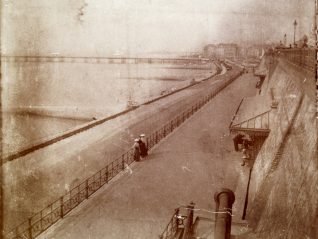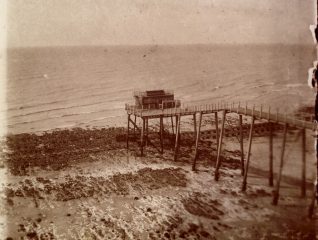Volk's Electric Railway 1904



I hope these views are of interest. Your comments and/or further information are very much welcomed.
1st Photo :-
Is this railway carriage still in use? Also worth noticing are the bathing machines, the sign (can anyone suggest what it might have said?), plus the horse-drawn omnibus (were three horses usual for this purpose?).
2nd Photo :-
Early morning, judging by the angle of the shadows and the emptiness of the scene; it must have been very peaceful. It can be seen along this stretch how the railway track and Madeira Drive ran parallel to each other and were very close to the sea at high water. The spray would sometimes break over. Next to the nearest groyne is a set of steps showing the significant drop from the road to beach level. The Palace Pier’s Winter Garden had yet to be constructed.
3rd Photo :-
The intermediary Ovingdean Gap halt of Volk’s “Daddy Longlegs” Railway, but photographed soon after the line had closed. The trolley standards and wire were immediately dismantled, and as seen here, the Sea-Going Car was moored to the jetty until 1910 when both, in serious decay, were completely removed. From 1907 new groynes broke the redundant track into disconnected sections of approximately 500 feet. By 1914 most of the rail had been salvaged, leaving only the concrete sleepers, many of which remain today.




Comments about this page
I love these sorts of photos and these in particular. The photo of the Volk’s carriage looks much the same today and you are right to wonder if it is still in use. What a pleasant thought if it is.
As a child, I had a theory that the warning ‘bell’ that drivers used, was a foot pedal that activated a hammer that struck one of the rails. Thus, the metallic sound. How near my theory was to the actuality, I don’t know.
I wondered, too, about the railings in these photos. They look very similar to the ones that exist today. Modern ones seem very likely to have been copied from the designs in these photos. Or is it too much of a stretch to wonder if they are still the originals?
Finding bits of the remains of the Daddy Longlegs was always an exciting game when I was a child in the 1950s. I don’t know how accurate we were, but any concrete blocks, found at low tide, to the east of the Palace Pier where always labelled, in our minds, as parts of the DL.
Please post more of these if you have them!
My family has a close association with the early days of Volk’s Railway. My great grandfather James Barker was described by the West Sussex Gazette as Volk’s “first engineer and [Magnus] Volk’s right-hand man over a long and difficult period of the railway’s history”. James also worked on the “Daddy Longlegs” and his son was a driver.
These are very interesting photographs Sam.
In the 1940s & 50s we used to go along the undercliff walk to the east of Black Rock Swimming Pool and explore the concrete blocks which had carried the rails for the Sea Going Railway. It was quite amazing that in spite of all the storms that the south coast had suffered over the years that so many of these survived just as they had been put there nearly seventy years earlier and many are still surviving now well over a hundred and twenty years later! A tribute to those Victorian workmen no doubt including your relatives Janet. A shame it lasted so few years, another lack of foresight to a magnificent British peculiarity.
Yes, the warning bell Philip; More like a large gong, was operated by a foot pedal, a large button which was located just in front of the driver’s feet. I well remember when these carriages were stored under the arches near the Madeira lift where they had been placed for safety during the War, on our way to the beach in the 1940s we used to go and play on them and stamp on this pedal to ‘ding’ the bell.
My forbear William Samuel Sargeant was associated with Magnus Volk as they were both pioneers in electric propulsion and connected with Moritz Immisch whose company manufactured early electric motors. William Sargeant built electrically powered launches which were used on the River Thames and several lakes around the country including The Marine Lakes at Southport and Roundhay Lake at Leeds. He held several patents in connection with electric motor control apparatus.
As an aside but relevant to Brighton sea front; Last summer we went to see and go over the Union Bridge across the River Tweed into Scotland which was designed and built by Captain Samuel Brown who had built the Chain Pier at Brighton. At least that does survive! It is well worth a look and gives an insight into the construction of the Chain Pier.
Thank you for your comments.
Philip, your theory concerning the method involved with the driver’s activation of the warning bell seems perfectly plausible to me, and has been read with interest. You ask about the railings : I do think it likely we see the original ones today. I presume it remains the same now, but the old railway blocks were always great places for finding shrimp/prawns!
Janet, thank you for mentioning James Barker. Long ago I read and enjoyed Conrad Volk’s “Magnus Volk of Brighton” (1971) but cannot remember if James and/or his son were mentioned in the book. Moens in “The Story of a Village” (1953) spoke of the “strongly nautical flavour about the whole affair, for it [Pioneer] was steered by a binnacle (even though it ran on rails) and if you asked an official for the time while you were ‘at sea’ [maybe James?] he would reply with some such comment as that it was ‘just after six bells'” (p. 37) ! The involvement of Richard St. George Moore in Volk’s Electric Railway projects – the designer/engineer/architect of the original Palace Pier structure – has always interested me.
Hello Sam. I don’t own a copy of Conrad Volk’s book, but it says this about my great uncle: “At about this time [c.1905], H.J. (‘Jimmy’) Barker followed his father on to the engineering staff of V.E.R., and the day that sturdy, indefatigable man signed on proved to be a fortunate one for all concerned.”
Tim, I only spotted your words a short while ago. Thank you for confirming the warning bell “theory” (with a wonderful childhood recollection), also for sharing such interesting and valuable information. I echo your thought “…another lack of foresight to a magnificent British peculiarity”.
Sometimes it can perhaps be easy to overlook the working conditions of those constructing the line ; a difficult, at times harsh, natural environment, very little in the way of labour-saving devices. It’s absolutely right to pay tribute to those Victorian labourers and the quality/permanency of the work they frequently produced. Concerning how much survives, I should have mentioned that a few of the bases of the trolley standards can still be found alongside the Pioneer track (I last saw the stubs of the Ovingdean Jetty decades ago).
I’m glad to have learnt about William Samuel Sargeant and Moritz Immisch’s connection to the work of Magnus Volk. I’ve found the Brentford & Chiswick Local History Society have a good page about William Samuel Sargeant and Moritz Immisch features well on Wikipedia and RootsWeb.
Lastly, thank you very much for informing me about the Union Chain/Suspension Bridge over the River Tweed at Berwick. I’ve been comparing photographs : its resemblance to Brighton’s Chain Pier, in many significant details, is striking. That I hadn’t known, and would now very much like to visit the bridge ; walking it must surely recreate something of what was experienced upon the Chain Pier, Brighton, and also Captain Samuel Brown’s earlier Trinity Chain Pier at Newhaven, Edinburgh.
Thank you for your kind words Sam.
Unfortunately Gillian Clegg who wrote the article on my forbear for the Brentford & Chiswick LHS mag has died. She was extremely knowledgeable about that area which covers Strand-on-the-Green where W S Sargeant had a couple of boatyards. If you wish to follow your interests in this direction; In Edward Hawthorne’s book, ‘Electric Launches on the Thames’, there is a chapter devoted to W S Sargeant who built one of the first electrically powered passenger launches for use on the River Thames. This was named The Viscountess Bury after Sophia the wife of Viscount Bury. He had been instrumental in the introduction of electric trams and financed the building of this launch which was unfortunately broken up at Lowestoft fairly recently. The only one of WSS’s boats known to survive is The Mary Gordon which is being restored at Lincoln.
I think it may have been an Immisch motor in Volk’s electric car, a photo of which is elsewhere on this site, hence the connection. In spite of quite a lot of research I haven’t been able to find a picture of the electric car that Volk built for the Sultan of Turkey.
Regarding the Union Bridge; It is quite easy to find being signed ‘Chain Bridge’ from the main road. You can actually drive over it into Scotland but it is interesting to stand in the middle when a vehicle goes across as there is about 6″ of vertical movement. This can be quite disconcerting!
Great photos Sam, particularly the one of the Ovingdean Gap Jetty. I have just compiled a book on the Daddy-long-legs railway for publication in September and would love to be able to include this photo. Would be happy to pay the required reproduction fee and give due credit and copies of the book. I have a large collection of postcards of the sea-going railway and also of Brighton’s three piers (I am author of the ‘Piers of Sussex’ book) which I would be happy to share with you.
Hello, Martin, and many thanks for your kind words. I’m sorry you’ve had to wait awhile for this reply. Your name is well-known to me, your excellent books have been appreciated over the years, particularly those concerning the piers of Sussex, Hampshire and the Isle of Wight.
Many thanks for the message Sam, I have sent you an email.
Best wishes
Martin
Anyone who is interested in Magnus Volk and his Sea Going Railway should purchase a copy of Martin Easdown’s book which has now been published.
‘The Extraordinary Daddy-Long-Legs Railway of Brighton’. Very interesting with many previously unseen photographs.
Add a comment about this page